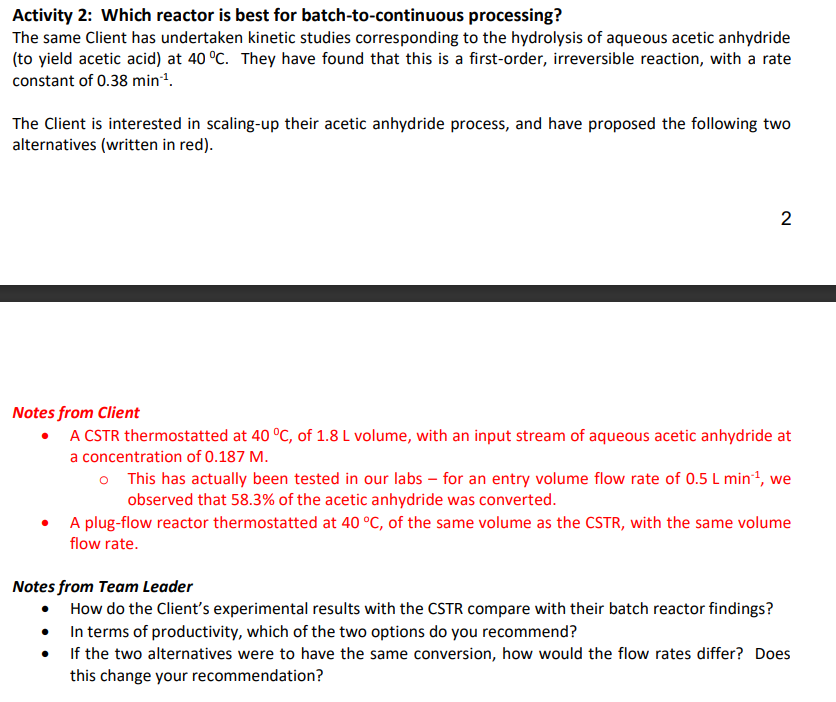The same Client has undertaken kinetic studies corresponding to the hydrolysis of aqueous acetic anhydride (to yield acetic acid) at 40 °C. They have found that this is a first-order, irreversible reaction, with a rate constant of 0.38 min ¹. The Client is interested in scaling-up their acetic anhydride process, and have proposed the following two alternatives (written in red). 2 Notes from Client • A CSTR thermostatted at 40 °C, of 1.8 L volume, with an input stream of aqueous acetic anhydride at a concentration of 0.187 M. • • • o This has actually been tested in our labs - for an entry volume flow rate of 0.5 L min-¹, we observed that 58.3% of the acetic anhydride was converted. A plug-flow reactor thermostatted at 40 °C, of the same volume as the CSTR, with the same volume flow rate. Notes from Team Leader How do the Client's experimental results with the CSTR compare with their batch reactor findings? In terms of productivity, which of the two options do you recommend? If the two alternatives were to have the same conversion, how would the flow rates differ? Does this change your recommendation?
The same Client has undertaken kinetic studies corresponding to the hydrolysis of aqueous acetic anhydride (to yield acetic acid) at 40 °C. They have found that this is a first-order, irreversible reaction, with a rate constant of 0.38 min ¹. The Client is interested in scaling-up their acetic anhydride process, and have proposed the following two alternatives (written in red). 2 Notes from Client • A CSTR thermostatted at 40 °C, of 1.8 L volume, with an input stream of aqueous acetic anhydride at a concentration of 0.187 M. • • • o This has actually been tested in our labs - for an entry volume flow rate of 0.5 L min-¹, we observed that 58.3% of the acetic anhydride was converted. A plug-flow reactor thermostatted at 40 °C, of the same volume as the CSTR, with the same volume flow rate. Notes from Team Leader How do the Client's experimental results with the CSTR compare with their batch reactor findings? In terms of productivity, which of the two options do you recommend? If the two alternatives were to have the same conversion, how would the flow rates differ? Does this change your recommendation?
Introduction to Chemical Engineering Thermodynamics
8th Edition
ISBN:9781259696527
Author:J.M. Smith Termodinamica en ingenieria quimica, Hendrick C Van Ness, Michael Abbott, Mark Swihart
Publisher:J.M. Smith Termodinamica en ingenieria quimica, Hendrick C Van Ness, Michael Abbott, Mark Swihart
Chapter1: Introduction
Section: Chapter Questions
Problem 1.1P
Related questions
Question
see image

Transcribed Image Text:processing?
Activity 2: Which reactor is best for batch-to-continuous
The same Client has undertaken kinetic studies corresponding to the hydrolysis of aqueous acetic anhydride
(to yield acetic acid) at 40 °C. They have found that this is a first-order, irreversible reaction, with a rate
constant of 0.38 min ¹.
The Client is interested in scaling-up their acetic anhydride process, and have proposed the following two
alternatives (written in red).
2
Notes from Client
• A CSTR thermostatted at 40 °C, of 1.8 L volume, with an input stream of aqueous acetic anhydride at
a concentration of 0.187 M.
o This has actually been tested in our labs - for an entry volume flow rate of 0.5 L min-¹, we
observed that 58.3% of the acetic anhydride was converted.
A plug-flow reactor thermostatted at 40 °C, of the same volume as the CSTR, with the same volume
flow rate.
Notes from Team Leader
• How do the Client's experimental results with the CSTR compare with their batch reactor findings?
In terms of productivity, which of the two options do you recommend?
•
If the two alternatives were to have the same conversion, how would the flow rates differ? Does
this change your recommendation?
Expert Solution
This question has been solved!
Explore an expertly crafted, step-by-step solution for a thorough understanding of key concepts.
Step by step
Solved in 4 steps

Recommended textbooks for you

Introduction to Chemical Engineering Thermodynami…
Chemical Engineering
ISBN:
9781259696527
Author:
J.M. Smith Termodinamica en ingenieria quimica, Hendrick C Van Ness, Michael Abbott, Mark Swihart
Publisher:
McGraw-Hill Education

Elementary Principles of Chemical Processes, Bind…
Chemical Engineering
ISBN:
9781118431221
Author:
Richard M. Felder, Ronald W. Rousseau, Lisa G. Bullard
Publisher:
WILEY

Elements of Chemical Reaction Engineering (5th Ed…
Chemical Engineering
ISBN:
9780133887518
Author:
H. Scott Fogler
Publisher:
Prentice Hall

Introduction to Chemical Engineering Thermodynami…
Chemical Engineering
ISBN:
9781259696527
Author:
J.M. Smith Termodinamica en ingenieria quimica, Hendrick C Van Ness, Michael Abbott, Mark Swihart
Publisher:
McGraw-Hill Education

Elementary Principles of Chemical Processes, Bind…
Chemical Engineering
ISBN:
9781118431221
Author:
Richard M. Felder, Ronald W. Rousseau, Lisa G. Bullard
Publisher:
WILEY

Elements of Chemical Reaction Engineering (5th Ed…
Chemical Engineering
ISBN:
9780133887518
Author:
H. Scott Fogler
Publisher:
Prentice Hall


Industrial Plastics: Theory and Applications
Chemical Engineering
ISBN:
9781285061238
Author:
Lokensgard, Erik
Publisher:
Delmar Cengage Learning

Unit Operations of Chemical Engineering
Chemical Engineering
ISBN:
9780072848236
Author:
Warren McCabe, Julian C. Smith, Peter Harriott
Publisher:
McGraw-Hill Companies, The